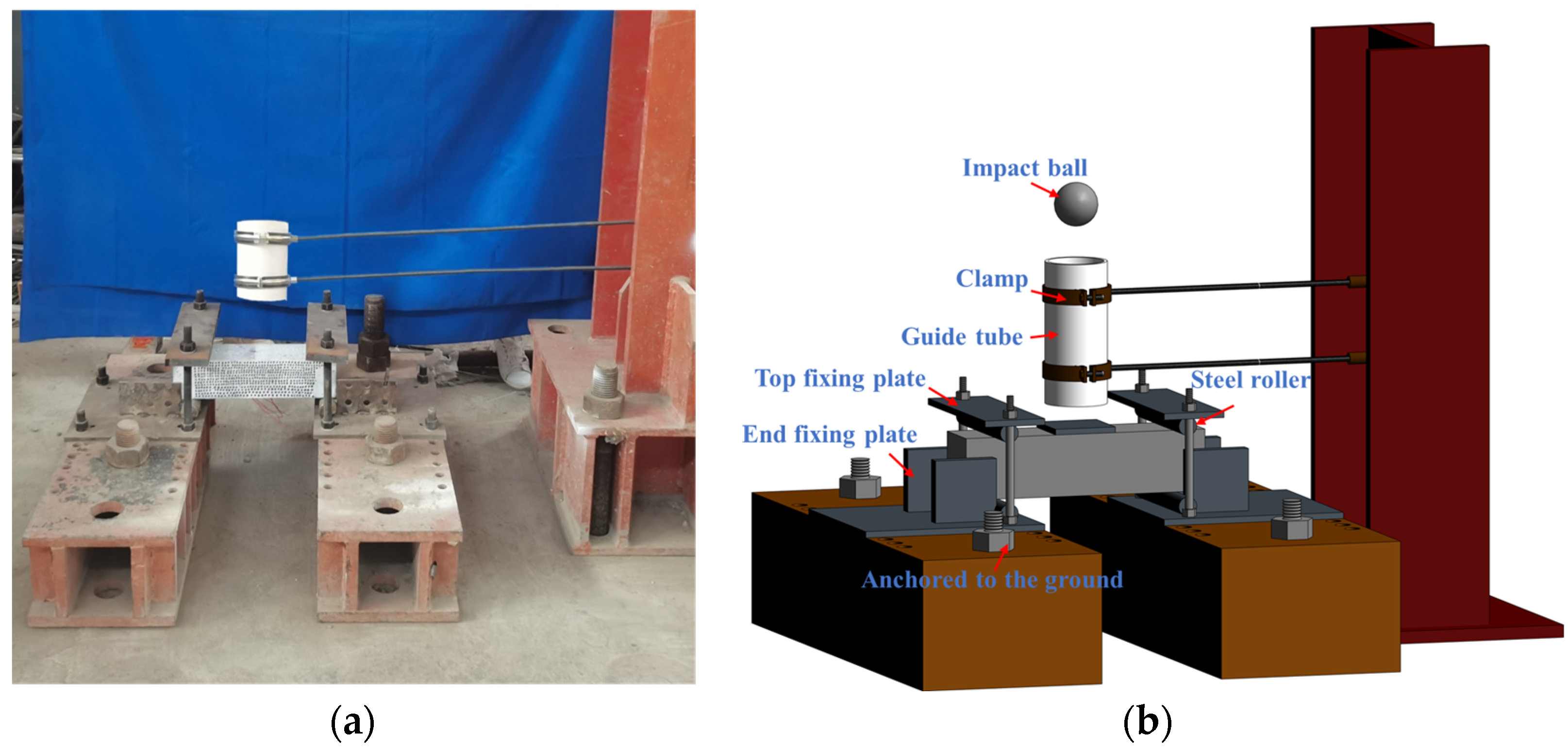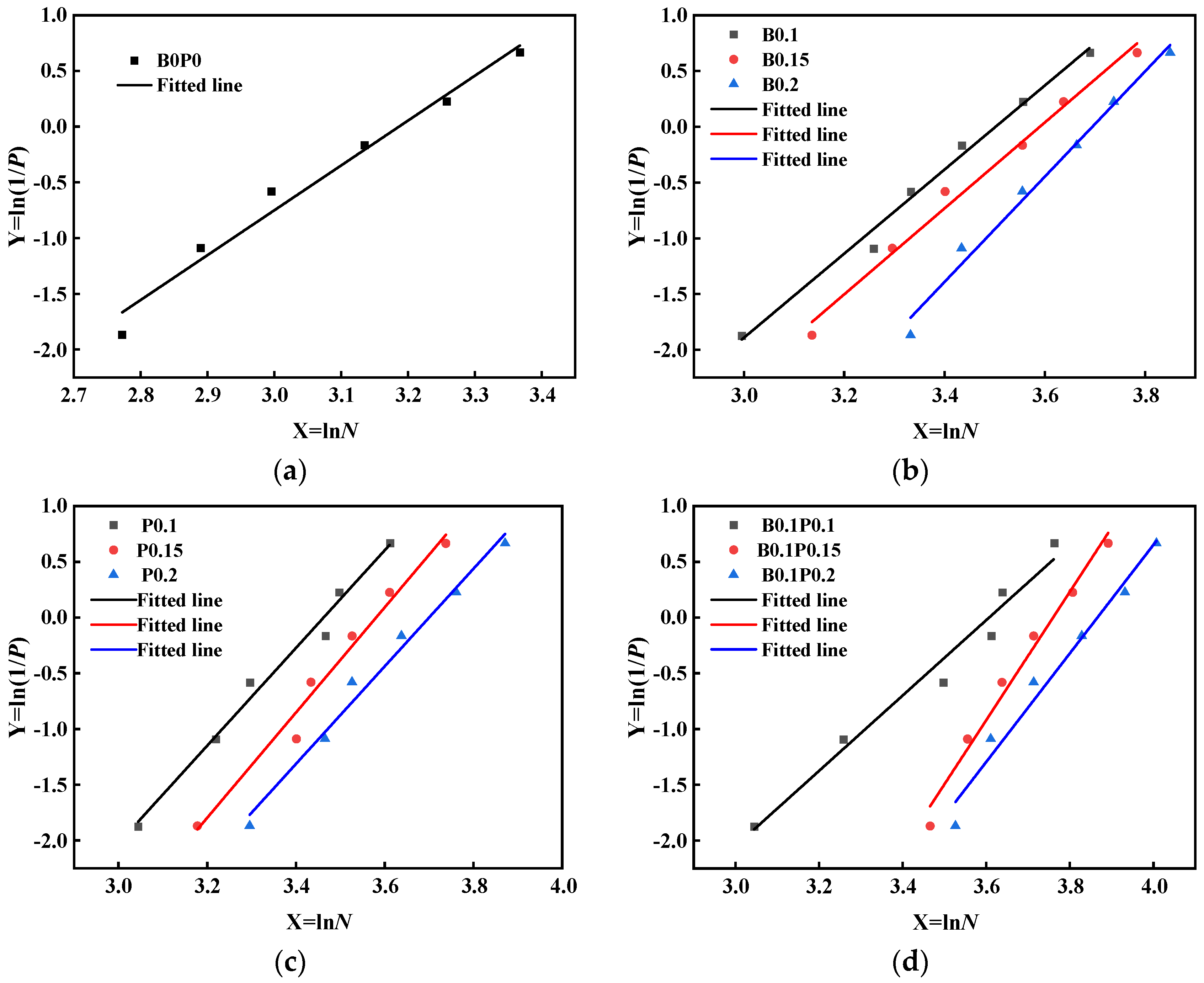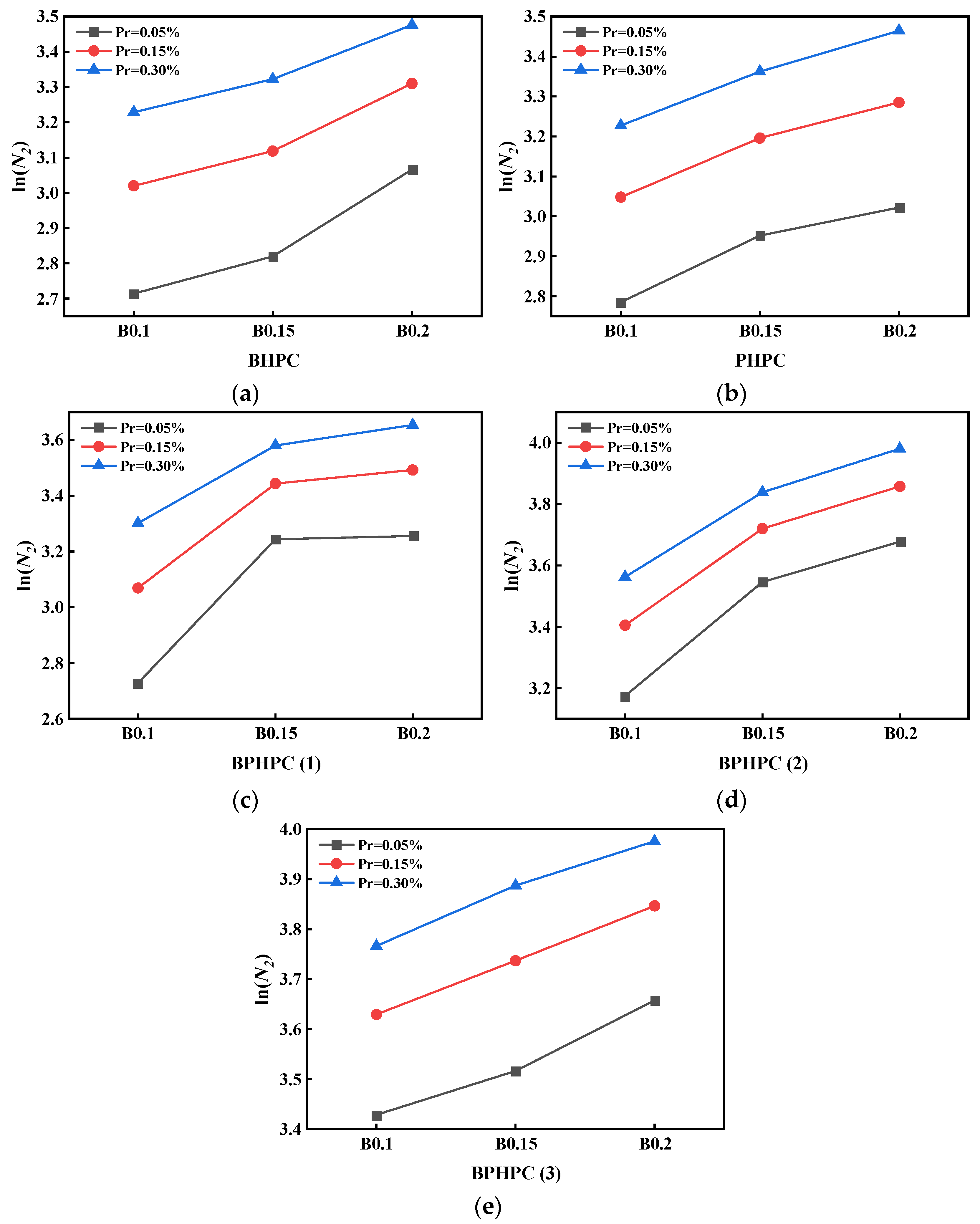Experimental Study on Impact Performance of Basalt-Polypropylene Fiber Reinforced High-Performance Concrete
Abstract
:1. Introduction
2. Experimental Program
2.1. Raw Materials
2.2. Mix Design of HPC and Fiber Content
2.3. Mixing Procedure and Specimen Preparation
2.4. Drop Weight Impact Test
3. Results and Discussion
3.1. Drop Weight Impact Test Results and Analysis
3.2. Weibull Distribution Model
3.3. Impact Life Estimation
3.4. SEM Results and Analysis
4. Conclusions
- (1)
- The impact energy dissipation of the specimens increases gradually regardless of whether a type of fiber or multi-fibers are added. There is little difference in impact resistance between the PHPC specimens and the BPHPC specimens at the same fiber content. HPC with 0.2 vol.% BF and 0.2 vol.% PF showed the best ductility and toughness and the most significant improvement in impact energy dissipation of the specimens with an increase of 168%.
- (2)
- The ability of the BHPC and PHPC specimens to absorb energy and resist deformation is enhanced compared to the control specimens. The maximum values for C and µ, representing the toughness index of concrete, are obtained from the BPHPC specimens, being 2.11 and 2.68, respectively. In addition, the probability distribution of N2 for the HPC specimens obeys well the two-parameter Weibull distribution. The N2 increases as the probability of failure increases. The calculated values of N2 for specimens with hybrid fibers are greater than those for specimens with single fibers at different probabilities of failure.
- (3)
- BF and PF have a synergistic effect when mixed, complementing each other and acting as a crack arrestor at different structural levels and at different loading stages. This effectively improves the impact damage resistance of HPC, which in turn exhibits better impact resistance than concrete without fibers and concrete with the addition of one type of fiber.
Author Contributions
Funding
Institutional Review Board Statement
Informed Consent Statement
Data Availability Statement
Conflicts of Interest
Abbreviations
| α | shape parameter |
| β | intercept |
| µ | ductility ratio |
| C | toughness coefficient |
| f(Nx) | probability density function |
| F(Nx) | cumulative distribution function of Nx |
| g | gravity acceleration |
| h | impact height |
| i | failure order number, = 1, 2, 3, …, n. |
| m | mass of the impact ball |
| n | total number of samples per group of specimens |
| Ni | number of impacts |
| Nx | specific value of the random variables (N1 and N2 in this experiment) |
| N0 | minimum life parameter |
| Na | scale parameter |
| N1 | number of impacts at first-crack generation |
| N2 | number of impacts at damage |
| Pr | failure probabilities |
| P(Nx) | survival probability |
| R2 | correlation coefficients |
| Wi | impact energy consumption |
| W0 | impact energy consumption of the control specimen |
| X | horizontal coordinate |
| Y | vertical coordinate |
References
- Ma, Y.Q. Experimental study on mechanical properties of steel fiber reinforced high performance concrete. Adv. Mater. Res. 2014, 859, 56–59. [Google Scholar] [CrossRef]
- Saje, D.; Bandelj, B.; Šušteršič, J.; Lopatič, J.; Saje, F. Shrinkage of polypropylene fiber-reinforced high-performance concrete. J. Mater. Civ. Eng. 2011, 23, 941–952. [Google Scholar] [CrossRef]
- Ayub, T.; Shafiq, N.; Nuruddin, M.F. Mechanical properties of high-performance concrete reinforced with basalt fibers. Procedia Eng. 2014, 77, 131–139. [Google Scholar] [CrossRef]
- Banthia, N.; Gupta, R. Influence of polypropylene fiber geometry on plastic shrinkage cracking in concrete. Cem. Concr. Res. 2006, 36, 1263–1267. [Google Scholar] [CrossRef]
- Yan, A.; Wu, K.; Zhang, X. A quantitative study on the surface crack pattern of concrete with high content of steel fiber. Cem. Concr. Res. 2002, 32, 1371–1375. [Google Scholar] [CrossRef]
- Wang, Y.; Zhang, S.; Luo, D.; Shi, X. Effect of chemically modified recycled carbon fiber composite on the mechanical properties of cementitious mortar. Compos. Part B Eng. 2019, 173, 106853. [Google Scholar] [CrossRef]
- Wongtanakitcharoen, T.; Naaman, A.E. Unrestrained early age shrinkage of concrete with polypropylene, PVA, and carbon fibers. Mater. Struct. 2007, 40, 289–300. [Google Scholar] [CrossRef]
- Qi, C.; Weiss, J.; Olek, J. Characterization of plastic shrinkage cracking in fiber reinforced concrete using image analysis and a modified Weibull function. Mater. Struct. 2003, 36, 386–395. [Google Scholar] [CrossRef]
- Grzybowski, M.; Shah, S.P. Shrinkage cracking of fiber reinforced concrete. Mater. J. 1990, 87, 138–148. [Google Scholar]
- Luo, X.; Sun, W.; Chan, S.Y.N. Steel fiber reinforced high-performance concrete: A study on the mechanical properties and resistance against impact. Mater. Struct. 2001, 34, 144–149. [Google Scholar] [CrossRef]
- Yet, T.C.; Hamid, R.; Kasmuri, M. Dynamic stress-strain behaviour of steel fiber reinforced high-performance concrete with fly ash. Adv. Civ. Eng. 2012, 2012, 907431. [Google Scholar] [CrossRef]
- Song, P.; Wu, J.; Hwang, S.; Sheu, B. Assessment of statistical variations in impact resistance of high-strength concrete and high-strength steel fiber-reinforced concrete. Cem. Concr. Res. 2005, 35, 393–399. [Google Scholar] [CrossRef]
- Li, P.; Cao, Y.; Sluijsmans, M.; Brouwers, H.; Yu, Q. Synergistic effect of steel fibres and coarse aggregates on impact properties of ultra-high performance fibre reinforced concrete. Cem. Concr. Compos. 2021, 115, 103866. [Google Scholar] [CrossRef]
- Krassowska, J.; Kosior-Kazberuk, M. Shear behavior of steel or basalt fiber reinforced concrete beams without stirrup reinforcement. Tech. Sci. 2017, 4, 391–404. [Google Scholar] [CrossRef]
- Fu, Q.; Niu, D.; Zhang, J.; Huang, D.; Wang, Y.; Hong, M.; Zhang, L. Dynamic compressive mechanical behaviour and modelling of basalt–polypropylene fibre-reinforced concrete. Arch. Civ. Mech. Eng. 2018, 18, 914–927. [Google Scholar] [CrossRef]
- Girgin, Z.C.; Yıldırım, M.T. Usability of basalt fibres in fibre reinforced cement composites. Mater. Struct. 2016, 49, 3309–3319. [Google Scholar] [CrossRef]
- Cao, H. Experimental investigation on the static and impact behaviors of basalt fiber-reinforced concrete. Open Civ. Eng. J. 2017, 11, 14–21. [Google Scholar] [CrossRef]
- Jiang, C.; Fan, K.; Wu, F.; Chen, D. Experimental study on the mechanical properties and microstructure of chopped basalt fibre reinforced concrete. Mater. Des. 2014, 58, 187–193. [Google Scholar] [CrossRef]
- Branston, J.; Das, S.; Kenno, S.Y.; Taylor, C. Mechanical behaviour of basalt fibre reinforced concrete. Constr. Build. Mater. 2016, 124, 878–886. [Google Scholar] [CrossRef]
- Zhou, M.; He, X.; Wang, H.; Wu, C.; He, J.; Wei, B. Mechanical properties and microstructure of ITZs in steel and polypropylene hybrid fiber-reinforced concrete. Constr. Build. Mater. 2024, 415, 135119. [Google Scholar] [CrossRef]
- Win, T.T.; Prasittisopin, L.; Jongvivatsakul, P.; Likitlersuang, S. Investigating the role of steel and polypropylene fibers for enhancing mechanical properties and microstructural performance in mitigating conversion effects in calcium aluminate cement. Constr. Build. Mater. 2024, 430, 136515. [Google Scholar] [CrossRef]
- Wang, J.; Dai, Q.; Si, R.; Guo, S. Mechanical, durability, and microstructural properties of macro synthetic polypropylene (PP) fiber-reinforced rubber concrete. J. Clean. Prod. 2019, 234, 1351–1364. [Google Scholar] [CrossRef]
- Banthia, N.; Gupta, R. Hybrid fiber reinforced concrete (HyFRC): Fiber synergy in high strength matrices. Mater. Struct. 2004, 37, 707–716. [Google Scholar] [CrossRef]
- Aly, T.; Sanjayan, J.G.; Collins, F. Effect of polypropylene fibers on shrinkage and cracking of concretes. Mater. Struct. 2008, 41, 1741–1753. [Google Scholar] [CrossRef]
- Bolat, H.; Şimşek, O.; Çullu, M.; Durmuş, G.; Can, Ö. The effects of macro synthetic fiber reinforcement use on physical and mechanical properties of concrete. Compos. Part B Eng. 2014, 61, 191–198. [Google Scholar] [CrossRef]
- Wang, D.; Ju, Y.; Shen, H.; Xu, L. Mechanical properties of high performance concrete reinforced with basalt fiber and polypropylene fiber. Constr. Build. Mater. 2019, 197, 464–473. [Google Scholar] [CrossRef]
- Zhang, H.; Wang, L.; Bai, L.; Addae, M.; Neupane, A. Research on the impact response and model of hybrid basalt-macro synthetic polypropylene fiber reinforced concrete. Constr. Build. Mater. 2019, 204, 303–316. [Google Scholar] [CrossRef]
- Blanco, I.; D’angelo, A.; Viola, V.; Vertuccio, L.; Catauro, M. Metakaolin-based geopolymers filled with volcanic fly ashes: FT-IR, thermal characterization, and antibacterial property. Sci. Eng. Compos. Mater. 2023, 30, 20220192. [Google Scholar] [CrossRef]
- Yin, W.; Li, X.; Sun, T.; Wang, J.; Chen, Y.; Yan, G. Experimental investigation on the mechanical and rheological properties of high-performance concrete (HPC) incorporating sinking bead. Constr. Build. Mater. 2020, 243, 118293. [Google Scholar] [CrossRef]
- Huang, W.; Kazemi-Kamyab, H.; Sun, W.; Scrivener, K. Effect of cement substitution by limestone on the hydration and microstructural development of ultra-high performance concrete (UHPC). Cem. Concr. Compos. 2017, 77, 86–101. [Google Scholar] [CrossRef]
- GB/T 21120-2018; Synthetic Fibers for Cement Concrete and Mortar. National Standards of People’s Republic of China: Beijing, China, 2018.
- Çelik, Z.; Bingöl, A.F. Fracture properties and impact resistance of self-compacting fiber reinforced concrete (SCFRC). Mater. Struct. 2020, 53, 50. [Google Scholar] [CrossRef]
- Li, J.; Qiao, H.; Zhu, F. Reliability analysis of fiber concrete freeze-thaw damage based on weibull method. Emerg. Mater. Res. 2020, 9, 70–77. [Google Scholar] [CrossRef]
- Bedi, R.; Chandra, R. Fatigue-life distributions and failure probability for glass-fiber reinforced polymeric composites. Compos. Sci. Technol. 2009, 69, 1381–1387. [Google Scholar] [CrossRef]
- Rahmani, T.; Kiani, B.; Shekarchi, M.; Safari, A. Statistical and experimental analysis on the behavior of fiber reinforced concretes subjected to drop weight test. Constr. Build. Mater. 2012, 37, 360–369. [Google Scholar] [CrossRef]






| Cement Grade | P.O 52.5 | |||
|---|---|---|---|---|
| Specific surface area (m2/kg) | 350 | Compressive strength (MPa) | 3 d | 29.2 |
| Specific gravity (g/cm3) | 3.26 | 28 d | 58.1 | |
| Initial setting time (min) | 160 | Flexural strength (MPa) | 3 d | 6.8 |
| Final setting time (min) | 220 | 28 d | 12.6 | |
| Composition | SiO2 | Al2O3 | Fe2O3 | MgO | Na2O | CaO |
|---|---|---|---|---|---|---|
| Content (%) | 96.16 | 0.30 | 0.44 | 0.29 | 0.08 | 0.03 |
| Water Demand Ratio (%) | Loss on Ignition (%) | Moisture Content (%) | SO3 (%) | f-CaO (%) |
|---|---|---|---|---|
| 92.8 | 0.43 | 0.01 | 0.44 | 0.29 |
| Fiber Type | Diameter: μm | Fiber Length: mm | Density: g/cm3 | Modulus of Elasticity: GPa | Tensile Strength: MPa | Fracture Elongation: % |
|---|---|---|---|---|---|---|
| BF | 15 | 12 | 2.65 | 93.1–110 | 3800–4800 | 3.1 |
| PF | 48 | 12 | 0.91 | 3.6 | 2976 | - |
| Types | Specimens | BF (%) | PF (%) | Total Ratio of Fibers (%) |
|---|---|---|---|---|
| Control | B0P0 | - | - | - |
| BHPC * | B0.1 | 0.10 | - | 0.10 |
| B0.15 | 0.15 | - | 0.15 | |
| B0.2 | 0.20 | - | 0.20 | |
| PHPC * | P0.1 | - | 0.10 | 0.10 |
| P0.15 | - | 0.15 | 0.15 | |
| P0.2 | - | 0.20 | 0.20 | |
| BPHPC | B0.1P0.1 | 0.10 | 0.10 | 0.20 |
| B0.1P0.15 | 0.10 | 0.15 | 0.25 | |
| B0.1P0.2 | 0.10 | 0.20 | 0.30 | |
| B0.15P0.1 | 0.15 | 0.10 | 0.25 | |
| B0.15P0.15 | 0.15 | 0.15 | 0.30 | |
| B0.15P0.2 | 0.15 | 0.20 | 0.35 | |
| B0.2P0.1 | 0.20 | 0.10 | 0.30 | |
| B0.2P0.15 | 0.20 | 0.15 | 0.35 | |
| B0.2P0.2 | 0.20 | 0.20 | 0.10 |
| Specimens | N1 | N2 | First-Crack Impact Energy: J | Percentage Increase: % | Impact Energy at Damage: J | Percentage Increase: % | Ductility Ratio C | Toughness Coefficient µ |
|---|---|---|---|---|---|---|---|---|
| B0P0 | 20 | 22 | 117.60 | - | 129.36 | - | 0.10 | - |
| B0.1 | 21 | 30 | 123.48 | 5% | 176.40 | 36% | 0.43 | 1.36 |
| B0.15 | 24 | 33 | 141.12 | 20% | 194.04 | 50% | 0.38 | 1.50 |
| B0.2 | 25 | 37 | 147.00 | 25% | 217.56 | 68% | 0.48 | 1.68 |
| P0.1 | 20 | 29 | 117.60 | 0% | 170.52 | 32% | 0.45 | 1.32 |
| P0.15 | 19 | 33 | 111.72 | −5% | 194.04 | 50% | 0.74 | 1.50 |
| P0.2 | 15 | 37 | 88.20 | −25% | 217.56 | 68% | 1.47 | 1.68 |
| B0.1P0.1 | 20 | 33 | 117.60 | 0% | 194.04 | 50% | 0.65 | 1.50 |
| B0.1P0.15 | 20 | 40 | 117.60 | 0% | 235.20 | 82% | 1.00 | 1.82 |
| B0.1P0.2 | 18 | 44 | 105.84 | −10% | 258.72 | 100% | 1.44 | 2.00 |
| B0.15P0.1 | 22 | 40 | 129.36 | 10% | 235.20 | 82% | 0.82 | 1.82 |
| B0.15P0.15 | 21 | 51 | 123.48 | 5% | 299.88 | 132% | 1.43 | 2.32 |
| B0.15P0.2 | 21 | 59 | 123.48 | 5% | 346.92 | 168% | 1.81 | 2.68 |
| B0.2P0.1 | 22 | 48 | 129.36 | 10% | 282.24 | 118% | 1.18 | 2.18 |
| B0.2P0.15 | 21 | 55 | 123.48 | 5% | 323.40 | 150% | 1.62 | 2.50 |
| B0.2P0.2 | 19 | 59 | 111.72 | −5% | 346.92 | 168% | 2.11 | 2.68 |
| Types | Specimens | C | ||
|---|---|---|---|---|
| α | β | R2 | ||
| HPC | B0P0 | 4.02743 | 12.83295 | 0.97713 |
| BHPC | B0.1 | 3.77034 | 13.20289 | 0.98953 |
| B0.15 | 3.85389 | 13.83538 | 0.98881 | |
| B0.2 | 4.72275 | 17.44962 | 0.98658 | |
| PHPC | P0.1 | 4.38559 | 15.18442 | 0.98512 |
| P0.15 | 4.72178 | 16.90726 | 0.97802 | |
| P0.2 | 4.37930 | 16.20379 | 0.98417 | |
| BPHPC | B0.1P0.1 | 3.37835 | 12.18561 | 0.97163 |
| B0.1P0.15 | 5.75300 | 21.63118 | 0.98221 | |
| B0.1P0.2 | 4.86590 | 18.81239 | 0.97489 | |
| B0.15P0.1 | 4.98917 | 18.80604 | 0.97075 | |
| B0.15P0.15 | 6.61403 | 26.42230 | 0.97878 | |
| B0.15P0.2 | 6.38131 | 26.43576 | 0.96349 | |
| B0.2P0.1 | 5.73299 | 22.62419 | 0.96630 | |
| B0.2P0.15 | 5.22391 | 21.33890 | 0.96605 | |
| B0.2P0.2 | 6.08715 | 25.23375 | 0.97433 | |
| Types | Specimens | Pr | ||
|---|---|---|---|---|
| 5% | 15% | 30% | ||
| HPC | B0P0 | 12 | 15 | 19 |
| BHPC | B0.1 | 15 | 20 | 25 |
| B0.15 | 17 | 23 | 28 | |
| B0.2 | 21 | 27 | 32 | |
| PHPC | P0.1 | 16 | 21 | 25 |
| P0.15 | 19 | 24 | 29 | |
| P0.2 | 21 | 27 | 32 | |
| BPHPC | B0.1P0.1 | 15 | 22 | 27 |
| B0.1P0.15 | 26 | 31 | 36 | |
| B0.1P0.2 | 26 | 33 | 39 | |
| B0.15P0.1 | 24 | 30 | 35 | |
| B0.15P0.15 | 35 | 41 | 46 | |
| B0.15P0.2 | 40 | 47 | 54 | |
| B0.2P0.1 | 31 | 38 | 43 | |
| B0.2P0.15 | 34 | 42 | 49 | |
| B0.2P0.2 | 39 | 47 | 53 | |
Disclaimer/Publisher’s Note: The statements, opinions and data contained in all publications are solely those of the individual author(s) and contributor(s) and not of MDPI and/or the editor(s). MDPI and/or the editor(s) disclaim responsibility for any injury to people or property resulting from any ideas, methods, instructions or products referred to in the content. |
© 2024 by the authors. Licensee MDPI, Basel, Switzerland. This article is an open access article distributed under the terms and conditions of the Creative Commons Attribution (CC BY) license (https://creativecommons.org/licenses/by/4.0/).
Share and Cite
Zhang, M.; Li, B.; Zheng, Z.; Zhang, J. Experimental Study on Impact Performance of Basalt-Polypropylene Fiber Reinforced High-Performance Concrete. Materials 2024, 17, 3253. https://doi.org/10.3390/ma17133253
Zhang M, Li B, Zheng Z, Zhang J. Experimental Study on Impact Performance of Basalt-Polypropylene Fiber Reinforced High-Performance Concrete. Materials. 2024; 17(13):3253. https://doi.org/10.3390/ma17133253
Chicago/Turabian StyleZhang, Maoyu, Bo Li, Zezhong Zheng, and Jicheng Zhang. 2024. "Experimental Study on Impact Performance of Basalt-Polypropylene Fiber Reinforced High-Performance Concrete" Materials 17, no. 13: 3253. https://doi.org/10.3390/ma17133253





